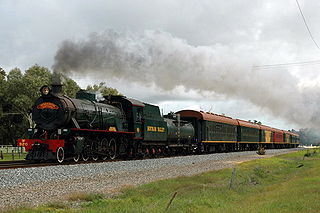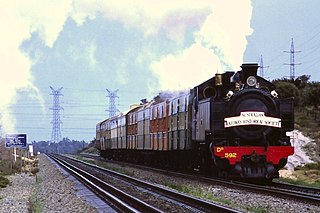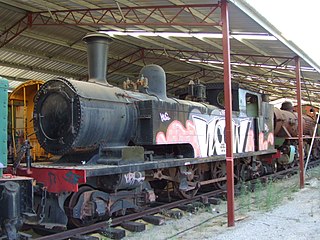Related Research Articles

The Prospector is a rural passenger train service in Western Australia operated by Transwa between East Perth and Kalgoorlie. On this service, two trains depart almost at the same time in opposite directions, one travelling between East Perth and Kalgoorlie, and the other between Kalgoorlie and East Perth. The original vehicles ordered in 1968 for trains providing this service were replaced in 2004 with vehicles capable of reducing journey times to 6 hours 45 minutes.

The Australind is a rural passenger train service in Western Australia operated by Transwa on the South Western Railway between Perth and Bunbury.

The Hotham Valley Tourist Railway is a tourist and heritage railway in the Peel region of Western Australia.

Western Australian Government Railways (WAGR) was the operator of railway services in the state of Western Australia between October 1890 and June 2003. Owned by the state government, it was renamed a number of times to reflect extra responsibility for tram and ferry operations that it assumed and later relinquished. Westrail was the trading name of WAGR from September 1975 until December 2000, when the WAGR's freight division and the Westrail name and logo were privatised. Its freight operations were privatised in December 2000 with the remaining passenger operations transferred to the Public Transport Authority in July 2003.

The Westland was the name given in 1938 to the overnight train operated by the Western Australian Government Railways (WAGR) with sitting and sleeping cars between Perth and Kalgoorlie, where it connected with the Trans-Australian service to Adelaide.

Railways in Western Australia were developed in the 19th century both by the Government of Western Australia and a number of private companies. Today passenger rail services are controlled by the Public Transport Authority through Transperth, which operates public transport in Perth, and Transwa, which operates country passenger services. Great Southern Rail operates the Indian Pacific.
The Mullewa was an overnight passenger train operated by the Western Australian Government Railways between Perth and Mullewa in the Mid West Region via the Eastern and Northern lines.

The X Class were a class of diesel locomotive built by Beyer, Peacock & Company and Metropolitan-Vickers, Bowesfield Works, Stockton-on-Tees for the Western Australian Government Railways between 1954 and 1956.

The WAGR Dd class was a class of 4-6-4T tank locomotive operated by the Western Australian Government Railways (WAGR) between 1946 and 1972.

The WAGR N class was a class of steam locomotives operated by the Western Australian Government Railways (WAGR) from 1896 until 1960.

The WAGR W class is a class of 4-8-2 steam locomotives operated by the Western Australian Government Railways (WAGR) between 1951 and 1972.

The WAGR S class was a class of 4-8-2 steam locomotives built by the Midland Railway Workshops between 1943 and 1947 and operated by the Western Australian Government Railways (WAGR).

The H class was a class of two steam locomotives operated by the Western Australian Government Railways (WAGR) introduced in 1889.

The C class are a class of diesel locomotives built by English Electric, Rocklea for the Western Australian Government Railways in 1962.

The WAGR U class was a class of 4-6-2 steam locomotives operated by the Western Australian Government Railways (WAGR) between 1946 and the late 1960s. One was rebuilt as a 4-6-4 tank locomotive.

The WAGR Pm and Pmr classes were two classes of 4-6-2 tender engine steam locomotives operated by the Western Australian Government Railways (WAGR) between 1950 and the early 1970s.

The WAGR G class is a class of steam locomotives operated by the Western Australian Government Railways (WAGR) from 1889. The class's wheel arrangement varied; the first 24 were 2-6-0s and the last 24 4-6-0s.

The WAGR ADF class was a six member class of diesel railcars operated by the Western Australian Government Railways between 1949 and 1975.
The Midlander was an overnight passenger train operated by the Western Australian Government Railways between Perth and Geraldton via the Midland line from September 1964 until July 1975.

WAGR G class G233 Leschenault Lady is a preserved 2-6-0 steam locomotive, built in 1898 by James Martin & Co of Gawler, South Australia, for the Western Australian Government Railways (WAGR). It is the third oldest Australian-built steam locomotive still in operational order, after Victorian Railways Y class 112 and WAGR A class 15.
References
- ↑ Lieutenant-Governor's Opening Speech Western Australian Legislative Council 3 August 1961 page 4
- ↑ WAGR Timetable book 1969 Table 41 and 42, p.86
- 1 2 3 Bromby, Robin (2004). The Railway Age in Australia. South Melbourne: Thomas Lothan. pp. 99/100. ISBN 0 7344 0715 7.
- 1 2 Ron Fitch (2006). Australian Railwayman: Cadet Engineer to Railway Commissioner. Kenthurst: Rosenberg Publishing. p. 215. ISBN 1 877058 48 3.
- ↑ Bromby, Robin (2006). Ghost Railways of Australia. Sydney: Lothian Books. p. 81. ISBN 0 7344 0923 0.
- 1 2 Higham, Geoffrey (2007). Marble Bar to Mandurah: A history of passenger rail services in Western Australia. Bassendean: Rail Heritage WA. pp. 115–118. ISBN 978 0 9803922 0 3.
- 1 2 May, Andrew S; Gray, Bill (2006). A History of WAGR Passenger Carriages. Midland, WA: Bill Gray. p. 312. ISBN 0646459023.
- ↑ History of HVTR Hotham Valley Railway